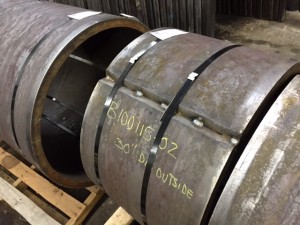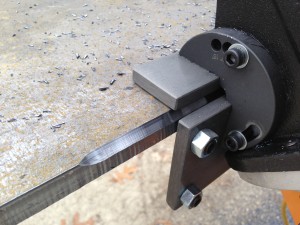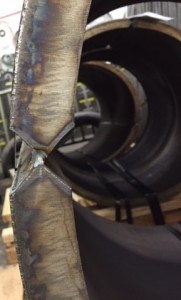One of the most common requests when working up bids for rolled plate segments or cylinders is to include weld preps in your scope of work. Welding preparation or weld prep for short is the process of readying the welding surfaces to a specific joint configuration; predetermined by a welding engineer through a written welding procedure which details the joint design or bevel detail and the method by means of beveling/chamfering.
Including weld preps in your rolled plate and cylinder quotes can be the deciding factor when it comes to the customer placing an order or not, as beveling is a much more involved process than most companies that put weld preps as an afterthought, would like to think. This is especially true when dealing with heavy plate, as the amount of material that needs to be removed during the beveling operation could be quite extensive. Without the proper beveling equipment, weld preps could easily be costing you more than realized in terms of quality and time, which in the end is really dollars flying out of your pocket.

To the welder, the weld prep is an extremely important part of the joint design, as it allows the filler metal a crevice to penetrate into the base metal being welded. The important word there is penetration; any weld that does not penetrate into the base metal, is somewhat like sticking bubble gum on the joint. The weld has no penetration to it and sits atop the base metal; this will likely not hold up to, nor pass, any testing. So a beveled edge on the seam of a rolled cylinder is a must if the joint is designed for complete or partial penetration. There are 4 main types of bevels/chamfers when it comes to rolled plate/cylinders, they are: Y, V, X & K. Y is symbolic for a beveled edge with a land. V is representative of a bevel with a knife edge. X & K are both double bevels where the plates edge at the seam of a rolled cylinders is chamfer cut on both sides; where X signifies both sides of the seam to be double beveled, and K is indicative of only one side of the seam being double beveled an but square to the other side of the seam. Another important aspect of the weld prep to the welder is edge quality. Edge quality and weldability go hand in hand; it is extremely important that whichever method of beveling is put into use, the quality of the cut edge must be clean and free of oxides which may compromise the welding process.

When deciding on a cutting method to implement for your weld preps it is important to consider what type of material is selected for the rolled plate or cylinder, whether it be Stainless Steel, Carbon Steel or Aluminum. But more so, the particular alloy of the metal that is specified for the rolled plate/cylinder, as the hardness of the determining alloy can vary greatly from one to another. Alloy hardness can significantly increase your cutting time when it comes to bevel/chamfer cuts.

On thin plates 1/8” to 3/8” a few options are available that can satisfy the bevel detail in the joint design. The most primitive of these options, which is likened to using tools from the “stone age”, is the angle grinder. The angle grinder takes little to no setup but it is extremely primitive and slow going. Depending on the hardness of the material alloy being beveled/chamfered, the angle grinder may even be ineffective. The inability to precisely control the angle grinder makes it extremely difficult to achieve any kind of complicated bevel design. The amount of material removed through the grinding process is minimal compared to the amount of effort it takes which really makes the angle grinder an undesirable method for beveling. Another method for cutting a bevel detail in thin plate is the portable milling head beveler. These machines are equipped with rotary milling heads and are small enough to be operated by hand. They produce a machined quality cut edge and have replaceable carbide cutting inserts. They are somewhat slow going and they do take a considerable amount of force to produce a cut as they are operated by hand but when compared to the angle grinder, the portable beveler is light years ahead in terms of technological advancement.
For heavy plate which can be considered anything over 3/8” up into the range of 2” there is larger, more efficient equipment for achieving a quality weld prep. It should be stated though, that while the machinery that is designed for performing chamfer cuts for bevel details on heavy plate, they are also very capable of performing the same high quality chamfer cut on thin plates all the way down to 3/16”; so this machinery is highly versatile. The peeling/shearing beveler is a common type of beveling machine that can perform simple bevels on heavy plate. Though the hardness of the alloy plays a major role in the success of this machine, as it depends on the material’s ability to be sheared, so tough materials like stainless steel are somewhat difficult to achieve a quality bevel. A negative aspect to this machine is that it has a high propensity for slipping off the plate’s edge and it must be adjusted and watched throughout the beveling process. Also, the edge quality of the cut that the peeling/shearing beveler leaves, looks somewhat like it was nibbled/chewed by a beaver’s teeth, which to some is considered undesirable. Another common method for performing chamfer cuts on heavy plate is a plasma cutting machine. Plasma cutters are automated through the use of a track & buggy system and leave high quality edge cuts and are capable of beveling carbon, stainless and aluminum in thicknesses over 2”. These machines use different combinations of consumables, shielding and cutting gases to give dross-free, oxide-free, highly weldable cut edges. The few drawbacks on this method of beveling are the time to setup the plasma cutter/track system and that it naturally leaves a heat affected zone on the plate’s cut edge that can make the edge of the plate much harder than the rest of the material. Also some alloy’s chemistry can change when enough heat is put into it leaving your edges as a completely different material alloy than the rest of the rolled plate/cylinder. The final option of performing weld prep cuts on rolled plate/cylinders 3/8” – 2” is the rotary mill head double beveler. With the same cutting principle as its little brother the portable beveler, the rotary mill head double beveler performs the bevel through a rotary milling head equipped with replaceable cutting inserts, but uses much more powerful motors to achieve the cuts. This type of machine usually is mounted to a 3D trolley of sorts that allows the beveling machine to “float” in air, adjusting itself to any uneven surfaces, and is fully automatic. The cut edge quality is superb and even high detailed bevel designs could be achieved through the precise control of bevel degree and amount of material being removed by the cutting heads. The great thing about the double beveling machines is that the machine rotates 180deg about the 3D trolley that it is mounted to, this allows bender/rollers to achieve a double bevel on their plate edges without having to flip the plate!
A vast array of equipment is available when it comes to selecting methods of achieving beveled cuts for weld preps. Some may consider weld preps as an afterthought, but those who are looking for a competitive advantage over the competition will give beveling a serious consideration on their next project.







